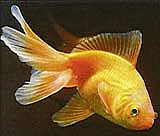Veil tail
| Veil tail |
|---|

|
| Breeding country of origin |
| China |

The veil tail is a cultivated form of the goldfish ( Carassius gibelio forma auratus (Bloch, 1782) ) (English "Veiltail").
origin
The first goldfish forms with split tail fin were bred in China probably in the 15th or 16th century . In China it is called " Chi yu ". The cultivated form with a split tail fin, which is similar to the Chinese character 文 ("wén") when viewed from above, is considered a real veil tail . Because of its appearance, which is the closest to the original cultivated form, the "Veiltail" deserves the name veil tail best. These wenge-shaped fish were also the starting products for the German "veil tail" of the late 19th century.
Veil tails and their cultivated forms are much more warm than the elongated species of their closest relatives because of their compact physique. They are generally more sensitive to injuries and therefore more suitable for keeping in the aquarium than in the pond. These fish never survive cold spells in ponds without problems.
Appearance and cultivated forms
There are various cultivated forms known as "veil tail", e.g. B. the "real" veil tail (English " veiltail ") and the fan tail. The ryukin ( Japanese 琉 金 "Ryūkyū gold" or 琉 錦 "Ryūkyū brocade") is also very well-known . It came from China to Japan via the Ryūkyū Islands and is very much cultivated there.
The back of this fish is curved very high. The veil tail has double tail fins that can reach a total length of 15 cm. He looks broad in his appearance.
The veil tail is available in red, orange, white and black, with two-tone spots. Sometimes it is even spotted in three colors. These goldfish have a short, more or less egg-shaped body. Good fish have a high, stiff dorsal fin that billows along the very edge of the dorsal edge.
The fan tail
The country of origin is China, but these fish are widespread in the west. They are called "a western form of the veil tails". That is an inadequate description; the difference to the veiltail veil tail or ryukin is that the tail fin is not hanging down like a veil, but is carried spread out.
Achievable size: You have to reckon with more than 20 cm under appropriate conditions; therefore one must not be misled by the often small sales size.
Keeping: A form that is relatively uncomplicated to keep , sometimes referred to as being sensitive to temperatures that are too low (not below 13 ° C). This shape is conditionally suitable for the pond . Here it depends very much on the individual constitution of the animal in question.
Torture breeding and animal welfare
So far none of the cultivated forms has been banned in Germany, even if they do not necessarily correspond to the general aesthetic perception. Section 11b of the Animal Welfare Act applies only to individual specimens, not to certain cultivated forms.
Cultivated forms that have the following characteristics are considered to be torture breeds:
- Deformations of the skeleton
- Loss of fins
- Artificial coloring
- Color changes due to genetic manipulation
- The changes in the head area that are specifically bred out are not, as is often claimed, cancerous tumors, but fatty tissue that can also be reversed in times of hunger.
- In the cultivated form "pompom goldfish", the growths of the nasal tentacles promoted by breeding can lead to problems with feeding and in the field of vision. In goldfish of the cultivated form "Ranchu" (lion's head) and "Oranda", the accumulation of fatty tissue in the head area can restrict the field of vision of the fish or even cause complete blindness if the eyes are overgrown. Good breeding selection must be ensured here.
- In the cultivated form "Himmelsgucker" the alignment of the eyes is changed so that the eyes are directed upwards and the fish can only see upwards.
- The cultivated form "bubble eye" has a shape that is pressed upwards under the eye by a balloon-like protuberance filled with liquid.
swell
- Chris Andrews: An Interpet Guide to Fancy Goldfish . Interpet Publishing, 2002, ISBN 1-902389-64-6 .
- Karl-Heinz Bernhardt: All goldfish and veil tails . In: Aqualog: reference fish of the world 11 . ACS Verlag, Rodgau 2001, ISBN 3-931702-78-2 .
- Erik L. Johnson, Richard E. Hess: Fancy Goldfish: A Complete Guide to Care and Collecting . Shambala Publications, 2006, ISBN 0-8348-0448-4 .
- Joseph Smartt: Goldfish Varieties and Genetics: A Handbook for Breeders . Blackwell Science, 2001, ISBN 978-0-85238-265-3 .
